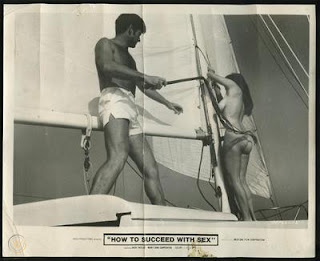Last month, we took a look at a then-current meme, Steamlyannaya Hamonika, which was brought to our attention by BoingBoing.* As we pointed out in April when covering the who, what, why, when and how of that slightly less than three-minute-long short, Steamlyannaya Hamonika, sold as coming from 1968 and being "the only animated film to be banned in the Soviet Union", is actually a new thing, a revisualization of an outtake from The Simpsons done by the Canadian Tyrone Diese in the style of this earlier and obscure and roughly 20-minute-long animated short made in the Soviet Union in 1968. That film, Steklyannaya Garmonika, did indeed become the only Soviet-made animated film to be banned in the Soviet Union.
* Cool site, but if you ever deign to take advantage of one of their offers, be prepared a daily spam mail or five. Not cool.
The plot of Steklyannaya Garmonika, through the eyes of mubi: "A craftsman builds a glass harmonica that enlightens him. He travels to a town where the people are obsessed with money. A bureaucrat smashes the glass harmonica which leads to chaos and eventually to social reform." While theoretically intended as a criticism of the west, the short was too easily interpreted as criticizing the Soviet system — thus, the ban.
Full short with subtitles –
Steklyannaya Garmonika:
Steklyannaya Garmonika was directed by Andrei Khrzhanovsky, a "Soviet and Russian animator, documentary filmmaker, writer and producer known for making art films". Still active today, alone in 2022 he produced more than six short films and, in 2020, produced & wrote & directed his most recent feature animated film, Nos ili zagovor netakikh / The Nose or Conspiracy of Mavericks (groovy trailer set to Dmitri Shostakovich's Waltz No. 2).Steklyannaya Garmonika's scriptwriter, Gennady Shpalikov (6 Sept 1937 – 1 Nov 1974), is no longer active today, as he killed himself roughly fifty years ago* — and while, if English is your native tongue, you probably don't know his name, he did have the posthumous honor, in 2009, of having a monument featuring him alongside Andrei Tarkovsky (4 Apr 1932 – 29 Dec 1986), the director of Solaris (1972 / trailer) and Stalker (1979 / trailer), and Vasily Shukshin (25 Jul 1929 – 2 Oct 1974), placed at the entrance to the Gerasimov Institute of Cinematography. "According to Sergei Solovyov, these [three] people defined the face of the national and world cinema during the second half of the 20th century. [Wikipedia (26.04.23)]"
* His farewell note: "No, it's not cowardice — I just can't live with you anymore. Do not grieve. I'm tired of you. Remember, Dasha. Shpalikov." His method, according to vk.com: he "hanged himself on the handle of the front door to Peredelkino."
"At the time Khrzhanovsky made the film, Russian animation had experienced a creative renaissance that spanned most of the '60s, fueled by the Soviet Union's post-Stalinist liberalization policy best known as the Krushchev Thaw. [...] Amid desolate modern landscapes, Khyrzhanovsky and his dozen animators tell the tale with some industrial age and Renaissance visual elements, along with some zany zoomorphic caricatures of paranoia and envy. Buoyed [by] drawing[s] from Bruegel, Dali and George Dunning (the director of Yellow Submarine [1968 / trailer]), Glass Harmonica reaches even proto-Python-esque heights towards the end. [Dangerous Minds]"
About making Steklyannaya Garmonika, Andrei Khrzhanovsky once said: "For making The Glass Harmonica,* I had to spend two years in the army. But at the same time, the government did give us money for film-making, and at one studio there'd be 40 films made in a year, as opposed to the two or three films made nowadays. The government had to give all the directors work; the problem was that when a film was ready, it might not be allowed on the screen. Russian animation has always been one of the best in the world. It still has the potential to be; the problem is that the amount of money that the government gives for making all the films in Russia equals the budget for one minute of Shrek (2001 / trailer). That's the main obstacle, really. [BFI]"
* Interesting note: the glass harmonica is a real instrument, invented by Benjamin Franklin in 1761. It looks nothing like that in Khrzhanovsky's film, but in real life master composers such as Beethoven, Mozart, and Donizetti are known to have composed music for the instrument. It enjoyed a period of great popularity, but inexplicable illnesses and deaths were eventually attributed to the instrument, which first led to its banishment in some places, its eventual unpopularity and, finally, its subsequent disappearance and obscurity.
Way back in 2004, that Turkish rock band that you never heard of, Mor ve Otesi, used the visuals of Steklyannaya Garmonika as the basis of the official video to their song Uyan ("Wake up"). Supposedly, the video reached third place on the MTV World Chart Express top videos list — not that that many people were still watching MTV for music videos in 2004.
The official music video —
Mor ve Otesi's Uyan:





















.png)


.png)



.png)
.png)




























































.jpg)





